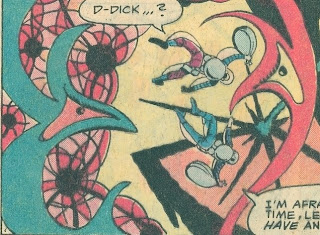Saturday, July 4, 2009
Chiffon
Posted by
Ken Parille
at
9:27 AM
3
comments
![]()
Ditko and the Beauty of Abstraction

 Ditko's version of an imaginary Martian machine owes less to contemporary science fiction and more to familiar cartoon abstractions. Take this panel for example:
Ditko's version of an imaginary Martian machine owes less to contemporary science fiction and more to familiar cartoon abstractions. Take this panel for example:

There’s a giant 'paint splat' surrounded by a fuzzy 'lightning bolt':

Even though a cartoon 'paint splat' has a representational connection to an actual one, here that connection is severed, for the nature of the object is unknown - it's just a gesture, a play of form and color. In the standard cartoon idiom, a splat would represent an action; here it may be an action or just a thing: in other words, in the grammar of this scene it could be either a subject or a verb.
Some 'cobweb'-like figurations: Many shapes suggest a flower seen through the fragmented prism of a kaleidoscope:
Many shapes suggest a flower seen through the fragmented prism of a kaleidoscope: At first, it’s almost hard to perceive these two creatures in the panel as life-forms--if that’s what the green shape (a rabbit/fish?) on the left and the red one on the right are intended to evoke:
At first, it’s almost hard to perceive these two creatures in the panel as life-forms--if that’s what the green shape (a rabbit/fish?) on the left and the red one on the right are intended to evoke:
In this three-panel sequence, the narrative aspect itself is almost abstract, seen in the panel-to-panel transformation of the shapes that make up the door:
In this panel, a character appears to comment ironically on the issues of representation and recognition; it’s obvious to Dick and Leo that it’s a city, but we might not think so if they hadn’t told us:
Perception depends heavily on context.
Ditko’s art in "The Dimensions of Greed" employs a play of distorted shapes and heightened exaggeration; and like this story, much of his work has an unrecognized sense of humor and playfulness. While many of the stories he draws grapple with ‘heavy’ themes (crime, justice, moral and psychological dilemmas, etc.), Ditko’s art often recalls the comical traditions of cartooning. And it looks like it would be fun to draw -- There's often a real feeling of joy to his art.
In this page from "Escape" (reprinted in Space Adventures #11, 1978; Charlton), Ditko's abstraction takes a more minimalist and geometrical approach. Underneath a highly stylized city (again, so abstract that the reader might not recognize it as such without textual clues), a man runs in the first panel: He says, "It looks like a street" but it’s just a series of circles or ovals floating in space. The next panel introduces, as the ‘ground’ of this world, a triangle and a cross, as well as two yellow triangles and other shapes created by the panel borders and the lines that define the purple cross and triangle:
He says, "It looks like a street" but it’s just a series of circles or ovals floating in space. The next panel introduces, as the ‘ground’ of this world, a triangle and a cross, as well as two yellow triangles and other shapes created by the panel borders and the lines that define the purple cross and triangle: The last panel above features a different kind of abstraction: Ditko literally abstracts (in the sense of removing) almost all sense of the physical context in which the figures ‘stand’ (except for the small shadow under a foot). The art in this story is sparse to begin with; but this scene takes that a step further, as each consecutive panel has less visual information.
The last panel above features a different kind of abstraction: Ditko literally abstracts (in the sense of removing) almost all sense of the physical context in which the figures ‘stand’ (except for the small shadow under a foot). The art in this story is sparse to begin with; but this scene takes that a step further, as each consecutive panel has less visual information.
Note how the floor of his "home" changes shape in the story's final two panels: a square surrounded other four-sided irregular shapes a series become all squares—and the oval shape of his room itself seems to become square: What's that big black ink area in the lower corner? Is it intentional or a Charlton printing error? [It oddly extends below the plane of the panel borders into the margin.] Either way, it fits with the abstract strangeness of the images.
What's that big black ink area in the lower corner? Is it intentional or a Charlton printing error? [It oddly extends below the plane of the panel borders into the margin.] Either way, it fits with the abstract strangeness of the images.
So often, Ditko is not interested in representing, in either a literal or conventional way, what the writer asks for; and this tendency is part of what makes his work so singular; he seems to rewrite the narrative as he draws it, making the finished story far subtler and stranger than what’s suggested by the script. Ditko is one of the few artists who can consistently take a mediocre script and make something special from it. And too often readers focus on Ditko's thematic concerns and not his formal innovations . . .
Posted by
Ken Parille
at
9:12 AM
8
comments
![]()
Labels: Abstraction, Close Reading, Ditko, Parille





